
An electronic calculator is typically a portable electronic device used to perform calculations, ranging from basic arithmetic to complex mathematics.

The Sinclair ZX80 is a home computer launched on 29 January 1980 by Science of Cambridge Ltd.. It is notable for being one of the first computers available in the United Kingdom for less than a hundred pounds. It was available in kit form for £79.95, where purchasers had to assemble and solder it together, and as a ready-built version at £99.95.
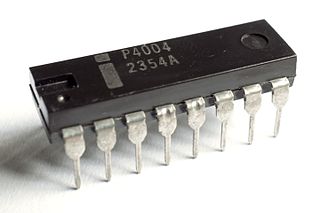
The Intel 4004 is a 4-bit central processing unit (CPU) released by Intel Corporation in 1971. Sold for US$60, it was the first commercially produced microprocessor, and the first in a long line of Intel CPUs.

The Sinclair Scientific calculator was a 12-function, pocket-sized scientific calculator introduced in 1974, dramatically undercutting in price other calculators available at the time. The Sinclair Scientific Programmable, released a year later, was advertised as the first budget programmable calculator.
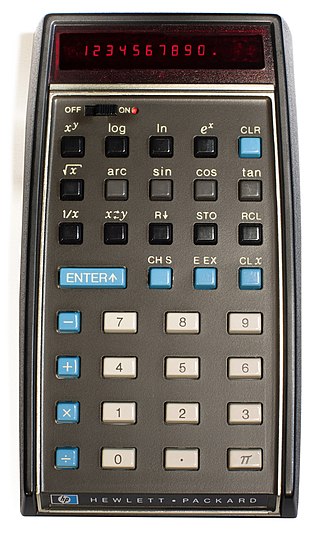
The HP-35 was Hewlett-Packard's first pocket calculator and the world's first scientific pocket calculator: a calculator with trigonometric and exponential functions. It was introduced in 1972.
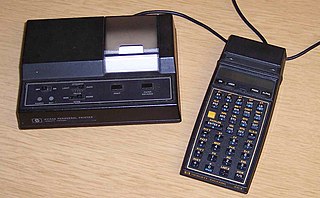
The HP-41C series are programmable, expandable, continuous memory handheld RPN calculators made by Hewlett-Packard from 1979 to 1990. The original model, HP-41C, was the first of its kind to offer alphanumeric display capabilities. Later came the HP-41CV and HP-41CX, offering more memory and functionality.

The HP-20S (F1890A) is an algebraic programmable scientific calculator produced by Hewlett-Packard from 1987 to 2000.
Sinclair Radionics Ltd was a company founded by Sir Clive Sinclair in Cambridge, England which developed hi-fi products, radios, calculators and scientific instruments.
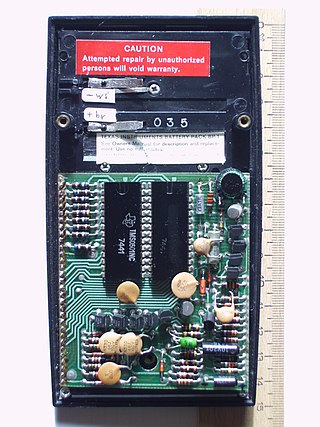
The SR-50 was Texas Instruments' first scientific pocket calculator with trigonometric and logarithm functions. It enhanced their earlier SR-10 and SR-11 calculators, introduced in 1973, which had featured scientific notation, squares, square root, and reciprocals, but had no trig or log functions, and lacked other features. The SR-50 was introduced in 1974 and sold for US$170. It competed with the Hewlett-Packard HP-35.

The Sinclair Executive was the world's first "slimline" pocket calculator, and the first to be produced by Clive Sinclair's company Sinclair Radionics. Introduced in 1972, there were at least two different versions of the Sinclair Executive, with different keyboard markings, and another called the Sinclair Executive Memory, introduced in 1973.
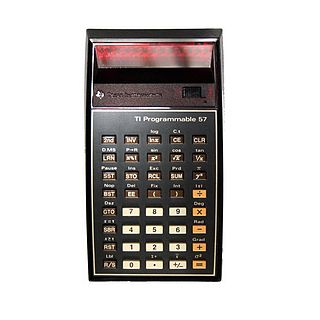
The TI-57 was a programmable calculator made by Texas Instruments between 1977 and 1982. There were three machines by this name made by TI, the first was the TI-57 with LED display released in September 1977 along the more powerful TI-58 and TI-59. It had 50 program steps and eight memory registers. Two later versions named TI-57 LCD and TI-57 LCD-II have a LCD display, but were less powerful and had much less memory: 48 bytes to be allocated between program 'steps' and storage registers.
Programmable calculators are calculators that can automatically carry out a sequence of operations under control of a stored program. Most are Turing complete, and, as such, are theoretically general-purpose computers. However, their user interfaces and programming environments are specifically tailored to make performing small-scale numerical computations convenient, rather than general-purpose use.

The HP-25 was a hand-held programmable scientific/engineering calculator made by Hewlett-Packard between early January 1975 and 1978. The HP-25 was introduced as a cheaper alternative to the ground-breaking HP-65.

The Sinclair Sovereign was a high-end calculator introduced by Clive Sinclair's company Sinclair Radionics in 1976. It was an attempt to escape from the unprofitable low end of the market, and one of the last calculators Sinclair produced. Made with a case of pressed steel that a variety of finishes, it cost between £30 and £60 at a time when other calculators could be purchased for under £5. A number of factors meant that the Sovereign was not a commercial success, including the cost, high import levies on components, competition from cheaper calculators manufactured abroad, and the development of more power-efficient designs using liquid-crystal displays. Though it came with a five-year guarantee, issues such as short battery life limited its usefulness. The company moved on to producing computers soon afterwards.
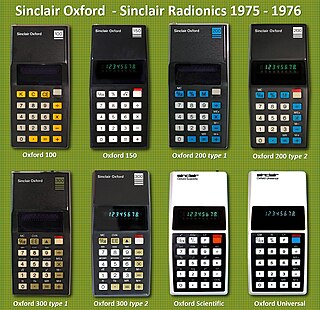
Sinclair Oxford was a range of low-cost scientific calculators manufactured and sold by Sinclair Radionics in England from 1975 until 1976.
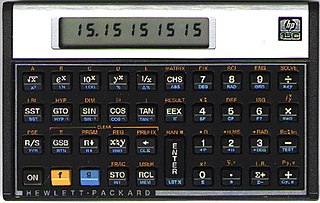
The HP-15C is a high-end scientific programmable calculator of Hewlett-Packard's Voyager series produced between 1982 and 1989.
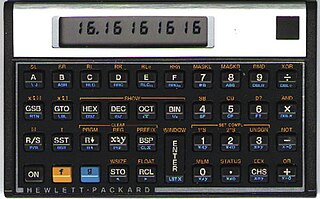
The HP-16C Computer Scientist is a programmable pocket calculator that was produced by Hewlett-Packard between 1982 and 1989. It was specifically designed for use by computer programmers, to assist in debugging. It is a member of the HP Voyager series of programmable calculators. It was the only programmer's calculator ever produced by HP, though many later HP calculators have incorporated most of the 16C's functions.

The Sinclair President is a calculator released by Sinclair Radionics in early 1978. There were two models, the President and the President Scientific. They were among the last calculators produced by Sinclair, and their large size was in contrast to the smaller, earlier models, like the Sinclair Executive, which made the company famous. The President models were related to the Sporting Life SETTLER, a calculator designed specifically for betting shops.

The FX-501P and FX-502P were programmable calculators, manufactured by Casio from 1978/1979. They were the predecessors of the FX-601P and FX-602P.

The fx-39 is a scientific calculator manufactured by Casio released in 1978 and is one of several models to share the same physical design format.




















